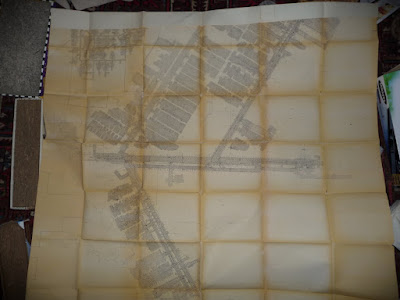I stayed in Illinois for eight months - from January of 1977 to August of 1977. I then went back to Madison (and had a great apartment - I lived above the Chocolate Shoppe on the corner of Gilman and State):
View Larger Map
I stayed in school for two semesters - September 1977 to May of 1978. Then I had to go back to work to pay for more school. I ended up at the Kemmerer Coal Company in Kemmerer (that is pronounced "Kemmer"), Wyoming.
I don't have many photos of Kemmerer, for some reason I was shooting slides at the time.
I got to Kemmerer in June of 1977. There is an interesting story about my ride (I was driving a 1965 Mercedes 220S at the time) that you can see
here.
At the Kemmerer Coal Company I was paid well to do real engineering "stuff". Mainly surveying. You were outside all day, wandering around the wilds of southwestern Wyoming, at about 8,000' elevation. IT was, at times invigorating, and sometimes very boring, depending on who the party chief was.
View Larger Map
We had a couple of young engineers there who did not really like to work too hard. So when I was assigned to one of their crews we took maybe three shots a day, and then spent the afternoon in bars. I figured that is how the real world works. Good training for a young engineer!
But when you worked with the Survey Chief you worked pretty hard. Now this guy - I will call him Bob Savage, because that is his name, was the original hard luck story.
Bob grew up in New Mexico, and had a hard luck childhood. (He must have been about 40 in 1978.) So to get out of the state, he joined the Navy. He wanted to see the world. The Navy made him a dental technician and sent him to the Mojave Desert, where he spent his pull cleaning teeth.
He ended up in Kemmerer after he flew up for an interview with the Mine Engineer. They got along fine, he was offered the job, and told to show up three weeks later. He returned to NM to get his family and things, drove back to Kemmerer and showed up at the appointed time.
When he got to the mine, there was nobody in the office. He waited, and finally some people started trickling in. He asked to see the Mine Engineer, and was met with a shocked silence. The Engineer had passed away in the intervening three weeks. Of course, there was no record of him being offered a job.
But they did need a job, and hired him, to his relief.
This bad luck extended to his whole life. Once, I was in the office with my crew (I was on e drilling crew at the time) and one of my guys kicked my truck out of gear leaving the vehicle. The truck rolled down, and guess whose car it ran into? You're right, Bob Savage's car.
Another time he was giving a fellow worker a ride home (the other fellow's car was in the shop) and had to stop and make a left turn he ordinarily would not make. The car behind him did not stop, and slammed into his car. The fellow he was giving a ride to was a big guy, and the car hit with such force the he broke the passenger side seat. No ticket was issued, and Bob had to pay for the entire repair.
Often times while surveying, we had downtime. We used that time to either play hearts (for money) or backgammon (also for money). Bob always lost. SO to make up his losses (which he didn't tell his wife about) he would throw the doubling cube on his FIRST ROLL!!! Now, if you ever play backgammon, you know that puts you in a sever disadvantage. I asked if he just wanted to raise the stakes, but that would not do.
Finally, while I was still living in Wyoming, Bob's wife joined some sort of a religious cult that did not believe in sex.
Poor bob.
I may have to make this post two posts.
This is the mine:
View Larger Map
That is the pit we called 1-U-d.
More in my next post. Where I will talk about this, too:



















































